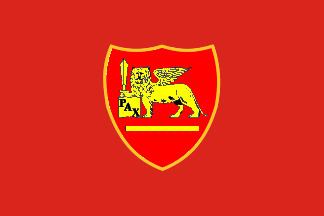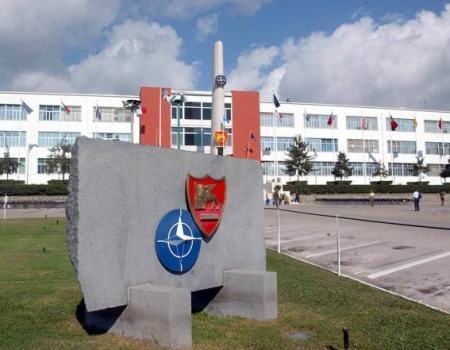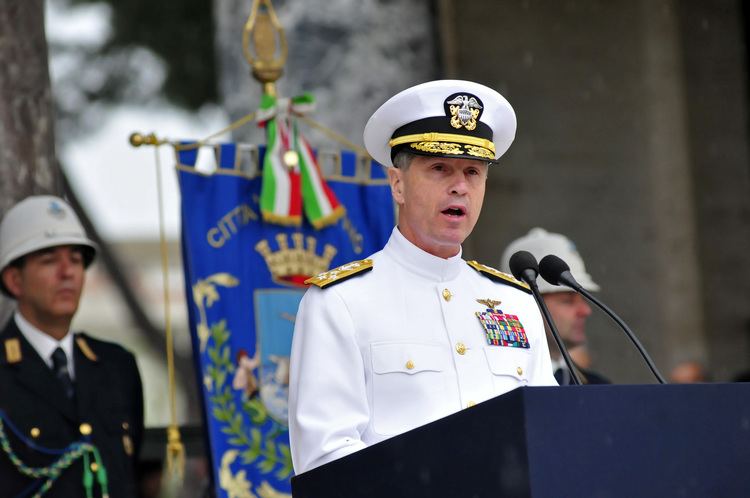Headquarters Giugliano in Campania | Founded 2004 | |
 | ||
Active AFSOUTH 1951 - 200415 March 2004 – present Engagements 2011 military intervention in Libya, Kosovo War, Bosnian War Similar Allied Joint Force Comman, Supreme Headquarters Allied Po, United States Naval For, Allied Command Transformation, NATO Response Force | ||
Allied joint force command naples transition video 2
Allied Joint Force Command (JFC) Naples (JFC Naples) is a NATO military command based in Lago Patria, in the Metropolitan City of Naples, Italy—the base was formerly located in the Bagnoli quarter of Naples. It was activated on 15 March 2004, after what was effectively a redesignation of its predecessor command, Allied Forces Southern Europe (AFSOUTH), originally formed in 1951. AFSOUTH in NATO Military Command Structure terms was a 'Major Subordinate Command.' Commander JFC Naples reports to the Supreme Allied Commander Europe at Supreme Headquarters Allied Powers Europe, Casteau, Belgium.
Contents
- Allied joint force command naples transition video 2
- Cold War
- Structure in 1989
- Post Cold War
- Joint Force Command Naples
- Role
- References

Cold War

Originally, Allied Forces Southern Europe was one of two major NATO commands in the Mediterranean area, the other being Allied Forces Mediterranean based on the island of Malta, responsible for naval activities in the region. While Admiral Robert B. Carney of the U.S. Navy was appointed as Commander-in-Chief Allied Forces Southern Europe (CinCAFSOUTH) on 19 June 1951, AFMED was not activated until 1953. The delay was due to negotiations and compromises between the Americans and the British, who wished to retain one of their commanders over Britain's traditional sea lines of communication stretching through the Mediterranean to the Suez Canal and beyond. From 1951 to 2003, the Commander-in-Chief of Allied Forces Southern Europe was always a United States Navy admiral, based at Naples, who also held the national appointment of Commander-in-Chief United States Naval Forces Europe. AFSOUTH headquarters was established at Nisida island, Naples.

The initial command arrangements for AFSOUTH consisted of the classic three land, sea, and air headquarters preferred by Eisenhower. Allied Land Forces Southern Europe (LANDSOUTH), Allied Naval Forces Southern Europe (NAVSOUTH), and Allied Air Forces Southern Europe (AIRSOUTH) were all established in Italy. Greece and Turkey joined the alliance in early 1952. On 8 September 1952, a new allied land command, Allied Land Forces South-Eastern Europe (LANDSOUTHEAST), was created with its headquarters based in Izmir, Turkey, under the command of a U.S. officer, Lieutenant General Willard G. Wyman. Under this command, with its headquarters in Izmir assisted by the subordinate Thessaloniki Advanced Command Post, were to be most of the Greek and Turkish armies in case of war.

The first AIRSOUTH commander became U.S. Major General David M. Schlatter, USAF. On 14 October 1953, the Sixth Allied Tactical Air Force was also established in Izmir, commanded by Major General R.E.L. Easton, USAF, and responsible to Allied Air Forces Southern Europe for the air defence of Greece and Turkey. Three national air Commands were assigned to it: the Turkish 1st and 3rd Tactical Air Forces, and the Greek Air Force's Royal Hellenic 28th Tactical Air Force. In terms of actual forces this meant two Greek wings and four Turkish fighter-bomber groups of F-84 aircraft, plus some B-26A Mosquitoes.
Later in 1953, the various national naval forces within Allied Forces Mediterranean were organised into six Sub-Principal Subordinate Commands (Sub-PSCs), each commanded by an Admiral (including one French (MEDOC), one Greek, one Turkish, one Italian and two British). In time of war, CINCAFMED would be responsible for securing the Sea lines of communications throughout the Mediterranean Sea.
Some of AFSOUTH's first exercises took place in 1952. Operation Ancient Wall was a series of military maneuvers involving ground small unit tactical training, land-based tactical air support, and carrier-based air support under the overall command of Admiral Carney. Exercise Grand Slam was a combined naval exercise held in the Mediterranean Sea between 25 February to 16 March 1952. The exercise included allied warships escorting three convoys of supply ships which were subjected to repeated simulated air and submarine attacks, as well as anti-submarine warfare (ASW) operations and naval gunfire shore bombardment. Operation Longstep was a ten-day naval exercise held in the Mediterranean Sea held during November 1952. It involved over 170 warships and 700 aircraft, and it featured a large-scale amphibious assault along the western coast of Turkey.
1953 AFSOUTH exercises included:
In 1957, Operation Deep Water simulated the defence of the Dardanelles from a Soviet attack. The exercise included an 8,000 strong amphibious landing.
The drawdown of the British Mediterranean Fleet, the military difficulties of the politically-decided command structure, and the withdrawal of the French from the military command structure forced a rearrangement of the command arrangements in the southern region. Allied Forces Mediterranean was disbanded on 5 June 1967, and all forces in the south and the Mediterranean assigned to AFSOUTH.
AFSOUTH continued to conduct exercises in the 1960s and 1970s, among which was exercise 'Dawn Patrol,' a five-nation naval and air exercise conducted throughout the Mediterranean in 1974. The U.S. contribution to the exercise was based on the USS America carrier battle group. During the 1960s Exercise Deep Furrow appears to have been held annually. Deep Furrow, will be conducted from 20–29 September 1973 in the southern region of Allied Command Europe. Forces from Greece, Turkey and other countries in AF South Command will participate in Exercise Deep Furrow 73, which is scheduled annually by CINCSOUTH. Land forces will hold maneuvers in Greek and Turkish Thrace and naval Force will exercise in the Eastern Mediterranean, including the Aegean Sea; naval activities will include amphibious and carrier operations. As part of the exercise, ground units will be airlifted from their home stations in the United Kingdom and the United States to northwestern Turkey, where Turkish National Forces will execute plans for receiving them. Turkish National Forces will also conduct operations with Hellenic Armed Forces and NATO air units providing fighter-bomber and recoinnaissance support throughout the area of operations. Highlights of the exercise in Turkish Thrace will be a multi-national amphibious landing on 25 sept 73 and a multi-national airborne operation on 26 sept 73.
From 1967 the overall shape of AFSOUTH did not significantly change until the command was renamed in 2004. There were five principal subordinate commands (PSCs). The number rose to six when Greece was taking part in the military structure; Greece withdrew from the NATO military structure after the Turkish invasion of Cyprus in 1974, and after some behind the scenes negotiating by NATO officials, returned in October 1980. Two land commands, Allied Land Forces Southern Europe and Allied Land Forces Southeastern Europe, were tasked to defend Italy and Turkey respectively. Each was directly responsible to Commander-in-Chief, AFSOUTH, and supported by a tactical air force, Fifth Allied Tactical Air Force in Italy and Sixth Allied Tactical Air Force in Turkey. The two allied tactical air forces were under an overall air command, Allied Air Forces Southern Europe, headquartered at Naples in Italy under a United States Air Force officer, ComAirSouth, responsible himself to CinCAFSOUTH. ComAirSouth held the U.S. national appointment of Commander Sixteenth Air Force for a long period.
Due to political considerations, command of the naval forces in the region was split. Allied Naval Forces Southern Europe, at Naples, operated most of the NATO allies' naval forces in the Mediterranean under an Italian admiral. But due to the U.S. desire to retain control of their nuclear-armed naval forces, the United States Sixth Fleet reported directly to CinCAFSOUTH, supported by a separate headquarters named Naval Striking and Support Forces Southern Europe (STRIKFORSOUTH).
The sixth command was an Allied command responsible for the land defence of Greece, named Allied Land Forces South-Central Europe or LANDSOUTHCENT. However it is not certain that it actually was ever operational, with the 1998/99 NATO Handbook listing it as 'yet to be activated.' Below these PSCs were smaller headquarters such as Maritime Air Forces, Mediterranean, at Sigonella, Sicily, responsible for coordination of the aerial anti-submarine effort, Submarine Forces, South, and the Naval On-Call Force Mediterranean, a multinational escort squadron activated at intervals.
Structure in 1989
At the end of the Cold War consisted of the following commands:
Post Cold War
From 1992 AFSOUTH was heavily involved in NATO operations in the Balkans, initially with NATO seaborne enforcement of a UN arms embargo, Operation 'Maritime Monitor,' which began in July 1992. This operation was fused with a similar Western European Union effort and thus became Operation Sharp Guard from July 1993. AFSOUTH also directed activities such as Operation Deny Flight from AIRSOUTH headquarters in Italy. Commander-in-Chief AFSOUTH directed the NATO peacekeeping missions in Bosnia & Hercegovina, IFOR and SFOR, from December 1995. While technically in charge of KFOR from mid-1999, General Sir Mike Jackson's autobiography, Soldier, indicates General Wesley Clark at SHAPE in Belgium directly supervised many of KFOR's activities, without going through AFSOUTH, at least during the Allied Rapid Reaction Corps' tour as HQ KFOR in 1999.
Beginning 10 July 1951, Headquarters Allied Land Forces Southern Europe was responsible for the defence of the Italian North-Eastern sector, in cooperation with other NATO nations. During the intervening 40 years, the HQ produced plans and studies to counter a potential invasion by the Soviet-led Warsaw Pact. After 53 years in the city of Verona, what had become Joint Command South (JCS) closed its doors on 15 June 2004. Also closing was Joint Headquarters Southwest in Madrid and Joint Headquarters Southeast/Joint Command Southeast in Izmir.
Joint Force Command Naples
The reorganisation of AFSOUTH as JFC Naples in 2004 was a part of NATO’s transformation, initiated by the Prague summit of 2002, aimed at adapting the allied military structure to the operational challenges of coalition warfare, to face the emerging threats in the new millennium. The new NATO Command Structure is leaner, and focused on conducting a much wider range of missions.
NHQ Sarajevo remains operational, and also NATO Headquarters Tirana, an outgrowth of the former Kosovo Force (KFOR) Communications Zone West originally established in 1999. Communication Zone West was retitled NHQ Tirana on 17 June 2002, and it now performs a Defence Reform and Security Sector Reform advisory role, aiming to support the Albanian Armed Forces, now a member of NATO.
In 2013 a further command structure reorganisation began to take effect. Allied Maritime Command Naples, Allied Air Command İzmir and Allied Force Command Madrid were all deactivated.
From 2013 Allied Command Operations started directing the Allied Joint Force Command Brunssum and Allied Joint Force Command Naples, and three component commands, Allied Air Command at Ramstein, Germany, Allied Land Command at Izmir, Turkey, and Allied Maritime Command at Northwood, UK.
NATO and Romanian Ministry of Defense representatives activated the Multinational Division Southeast (NATO) (MND-SE) headquarters in Bucharest, Romania, on December 1, 2015. The new HQ was activated as part of the Readiness Action Plan agreed at the 2014 Wales Summit. JFC Naples will serve as the operational control of MND-SE. The division HQ will be prepared to execute command and control over the NATO Force Integration Units in Romania and Bulgaria for a range of missions, which includes Article V operations based on NATO advance planning, when authorized by the North Atlantic Council and directed by the Supreme Allied Commander Europe.
Role
Commander, Allied Joint Force Command Naples, is responsible for conducting the full range of military operations throughout the NATO Area of Responsibility (AOR) and beyond in order to deter aggression and to contribute to the effective defence of NATO territory and forces, safeguard freedom of the seas and economic lifelines and to preserve or restore the security of NATO nations.
